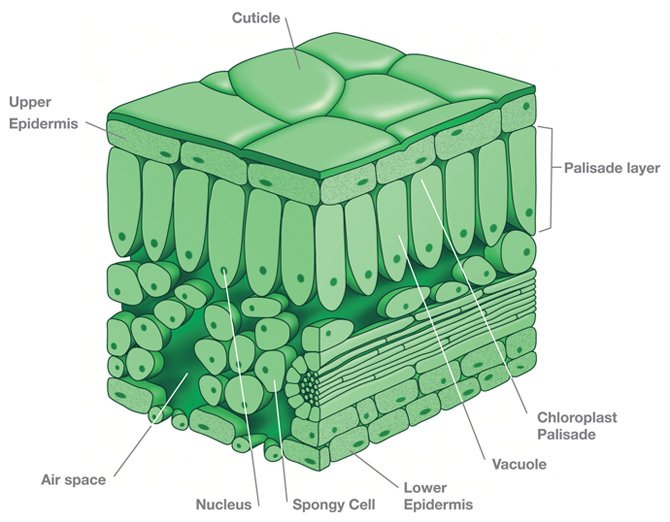
 |
|
Hydroponics - Indoor HorticultureHydroponics - Indoor Horticulture represents an educational, in-depth,
up-to-date, indoor horticultural growers guide that covers all principles
of indoor Hydroponics - Indoor Horticulture examines, explores, dissects and
presents a fully comprehensive step by step growers guide, relating
to all and every aspect of indoor hydroponic horticulture, with complete
chapters on plant biology, propagation, hydroponic systems, nutrients,
oxygen, carbon dioxide enrichment, pH, biological pest control, fungi/disease,
cuttings/clones, pruning/training, breeding, harvesting, equipment,
grow rooms, a full history of hydroponics, and more. |
| (Below follows a one page sample taken from the book) |

| Example of a Cross Section of a Leaf |
LeavesLeaves are the manufacturers of plant sugars. They utilise the light
to combine water, nutrient and carbon dioxide to produce sugars which
are then sent down the stem to feed the rootball. Aweak link in any
of these areas – light, water, nutrient, or CO2 can prohibit the
plant from producing as it should. The leaves cause water and nutrient to be drawn up from the roots
via the stem to the leaves. Excellent leaf development makes it possible
to suck up lots of nutrients, water and air which in turn creates lots
of excess sugar to be sent down to the root system. These leaves are
constantly pushing out energy to the plant and the roots and when optimised,
the leaves create so much starch that they begin to store the excess
in the tissues of the leaf. During the night cycle this stored energy
is diverted down to the roots. The healthier the leaves left on the
plant, the better this process is, the healthier the leaf system is,
the more energy it will create for further storage within the plant.
The more stored energy, the greater the yield potential of the plant.
|
to feed the root system and the leaves at the top of the plant are mainly used to feed the new shoots, fruit or flowering sites. The leaves in the middle of the plant feed the plant’s needs either way depending on the condition of the plant and what cycle the plant is in. The more leaves that are able to collect light, the bigger the root system will become and the more stored energy will be left in the plant. This store of energy gives the plant the best chance of producing greater yields, therefore, do not strip any leaves from the plant. In recent years, techniques have been published such as the 24 hour light cycle and the stripping of leaves, especially the larger ones, which apparently then allowed for greater fruit or flower formations. This, like the 24 hour light regime is a total myth and should be disregarded as utter nonsense! However, leaves are subject to entropy like any natural
thing, so when the leaves have matured and turn yellow and are ready to
die then these yellowing leaves may be removed. It is good practice to
remove the older dying leaves in one fell swoop. Every time you subject
a plant to a cut, it goes into shock for a few days and the plant will
not do any growing during this period. So if you cut one leaf a day over
the course of a week, it will not grow at all over this period of time.
Never remove dark healthy leaves as these leaves are in full swing production for the plant’s needs. Removing these leaves will curb the available potential of the plant resulting in under yielding crops. The majority of leaf development is created during what is known as the vegetative cycle of the plant’s growth. This cycle is normally related to the photoperiod of 18-20 hours lights on and 6-4 hours lights off. It is possible to sustain a plant predominantly in a vegetative state by subjecting the plant to this photoperiod. A mother plant for example would be kept perpetually on this cycle in order to never allow it to fruit or flower so that clones can be made at any time the gardener wishes. When you reduce the photoperiod down to 12 hours lights on and 12 hours lights off, the plant is tricked into flowering, however, for at least 2 weeks after the switch to 12/12, the plants would still be in vegetative growth. |
|
 |